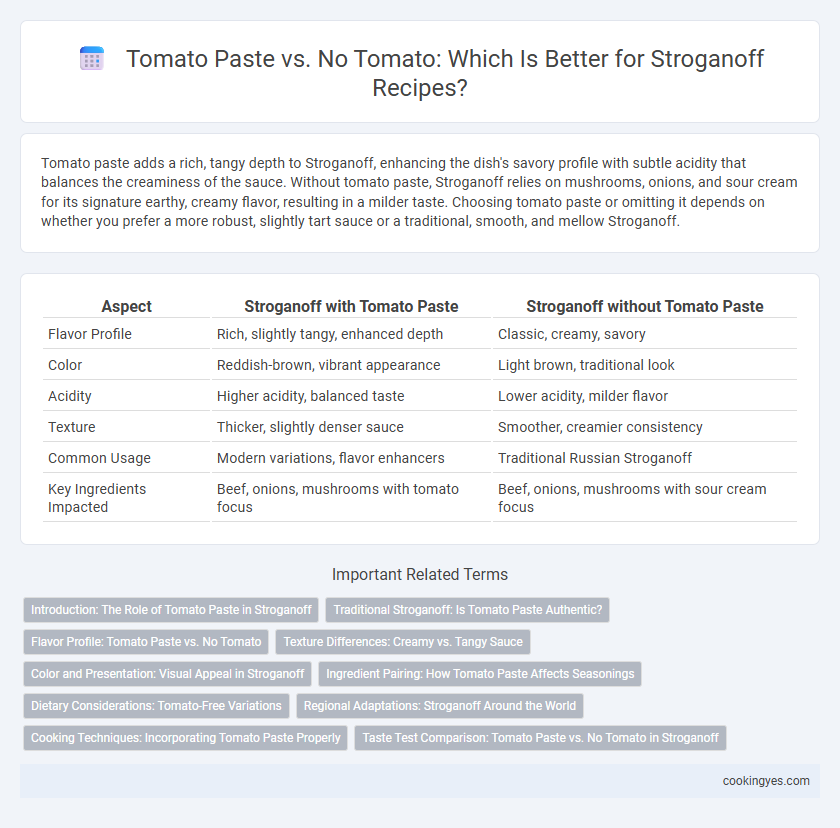Tomato paste adds a rich, tangy depth to Stroganoff, enhancing the dish's savory profile with subtle acidity that balances the creaminess of the sauce. Without tomato paste, Stroganoff relies on mushrooms, onions, and sour cream for its signature earthy, creamy flavor, resulting in a milder taste. Choosing tomato paste or omitting it depends on whether you prefer a more robust, slightly tart sauce or a traditional, smooth, and mellow Stroganoff.
Table of Comparison
| Aspect | Stroganoff with Tomato Paste | Stroganoff without Tomato Paste |
|---|---|---|
| Flavor Profile | Rich, slightly tangy, enhanced depth | Classic, creamy, savory |
| Color | Reddish-brown, vibrant appearance | Light brown, traditional look |
| Acidity | Higher acidity, balanced taste | Lower acidity, milder flavor |
| Texture | Thicker, slightly denser sauce | Smoother, creamier consistency |
| Common Usage | Modern variations, flavor enhancers | Traditional Russian Stroganoff |
| Key Ingredients Impacted | Beef, onions, mushrooms with tomato focus | Beef, onions, mushrooms with sour cream focus |
Introduction: The Role of Tomato Paste in Stroganoff
Tomato paste in Stroganoff introduces a rich umami depth and subtle tang, enhancing the flavor profile without overpowering the dish's creamy base. Traditional Stroganoff recipes often omit tomato paste to preserve the delicate balance of mushrooms, sour cream, and beef, maintaining its classic Eastern European authenticity. Including tomato paste modifies both color and acidity, influencing texture and taste perception in the final dish.
Traditional Stroganoff: Is Tomato Paste Authentic?
Traditional Stroganoff recipes typically do not include tomato paste, emphasizing a creamy sauce made from sour cream, beef broth, and mustard for its signature tangy flavor. Authentic Russian Stroganoff relies on sauteed mushrooms and onions, with no tomato-based ingredients altering the dish's classic taste profile. Incorporating tomato paste is considered a modern adaptation rather than a traditional element in Stroganoff preparation.
Flavor Profile: Tomato Paste vs. No Tomato
Tomato paste adds a rich umami depth and slight acidity to Stroganoff, enhancing the dish's savory complexity while balancing the creaminess of sour cream. Without tomato paste, the flavor profile remains more mellow and traditional, highlighting the tender beef and earthy mushrooms with a subtle, creamy richness. The choice between including tomato paste or not significantly influences the dish's overall taste, with tomato imparting a tangy robustness and omission preserving a classic, delicate harmony.
Texture Differences: Creamy vs. Tangy Sauce
Tomato paste in Stroganoff creates a tangy sauce with a slightly thicker texture that balances the creaminess of sour cream, enhancing the overall robustness. Without tomato paste, the sauce remains smooth and creamy, highlighting the richness of mushrooms and beef without added acidity. The choice between tomato paste or no tomato significantly influences the dish's flavor depth and mouthfeel, tailoring the Stroganoff's signature texture.
Color and Presentation: Visual Appeal in Stroganoff
Tomato paste in Stroganoff recipe enhances color by adding a rich, reddish hue that intensifies visual appeal, creating a more vibrant presentation. Without tomato paste, the dish maintains a traditional creamy beige tone, highlighting the earthy mushroom and beef elements for a classic look. Choosing between tomato paste or not directly impacts the Stroganoff's appearance, influencing diners' initial perception and appetite stimulation.
Ingredient Pairing: How Tomato Paste Affects Seasonings
Tomato paste in Stroganoff introduces a rich umami depth that enhances the savory profile while balancing the creaminess of sour cream with subtle acidity. It pairs well with seasonings like paprika, garlic, and black pepper, helping to meld these flavors into a harmonious sauce. Without tomato paste, Stroganoff relies more heavily on the natural savoriness of mushrooms and beef broth, allowing herbs like thyme and dill to stand out more distinctly.
Dietary Considerations: Tomato-Free Variations
Tomato-free Stroganoff recipes cater to individuals with nightshade allergies or acid sensitivity, offering a milder, less acidic flavor profile. Using alternatives like beef broth, sour cream, and mushrooms maintains the dish's creamy texture without compromising taste. Removing tomato paste also reduces the risk of digestive discomfort for those with certain dietary restrictions.
Regional Adaptations: Stroganoff Around the World
Tomato paste is a common ingredient in Brazilian and Eastern European versions of Stroganoff, adding a rich, tangy depth to the sauce that enhances the beef's flavor. In contrast, traditional Russian Stroganoff often omits tomato paste, relying on sour cream, mustard, and mushrooms to create a creamy, tangy sauce. These regional adaptations highlight the balance between acidity and creaminess, reflecting local taste preferences and ingredient availability.
Cooking Techniques: Incorporating Tomato Paste Properly
Incorporating tomato paste into Stroganoff enhances the sauce's depth and richness by adding a subtle acidity that balances the creamy elements. To avoid bitterness and maximize flavor, saute the tomato paste in oil or butter for 1-2 minutes before adding liquids, allowing the sugars to caramelize. This technique ensures a well-rounded taste and a vibrant color without overpowering the dish's traditional creamy profile.
Taste Test Comparison: Tomato Paste vs. No Tomato in Stroganoff
Using tomato paste in Stroganoff introduces a rich umami depth and subtle acidity that enhances the beef's savoriness, creating a more robust flavor profile. In contrast, Stroganoff without tomato paste offers a creamier, more traditional taste focused on sour cream and mushroom flavors, preserving the classic Russian origins. Taste tests reveal that tomato paste versions appeal to those seeking a tangier, heartier dish while the no-tomato version satisfies purists desiring a smooth, balanced creaminess.
Tomato paste vs no tomato for Stroganoff recipe Infographic

 cookingyes.com
cookingyes.com